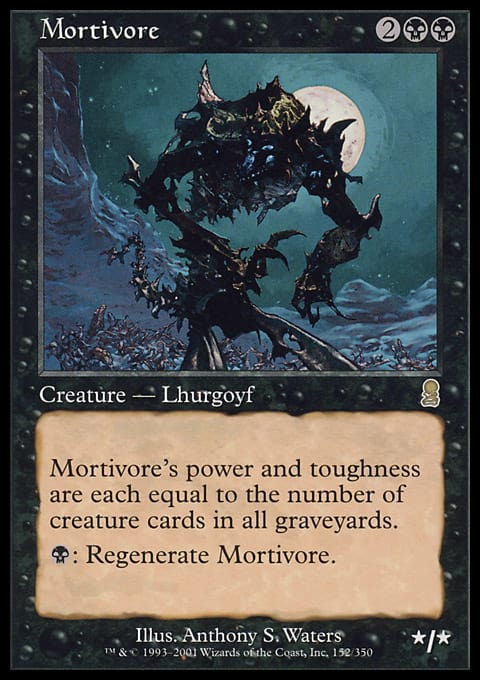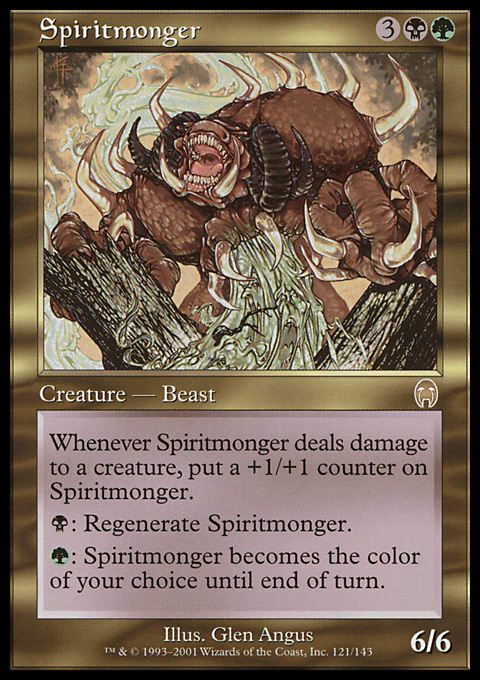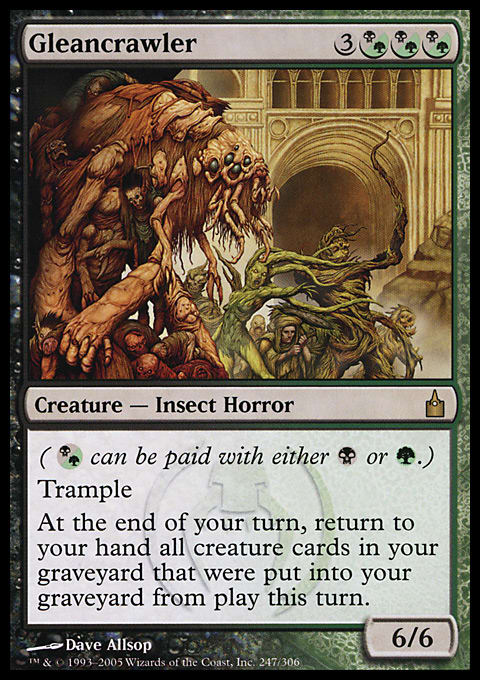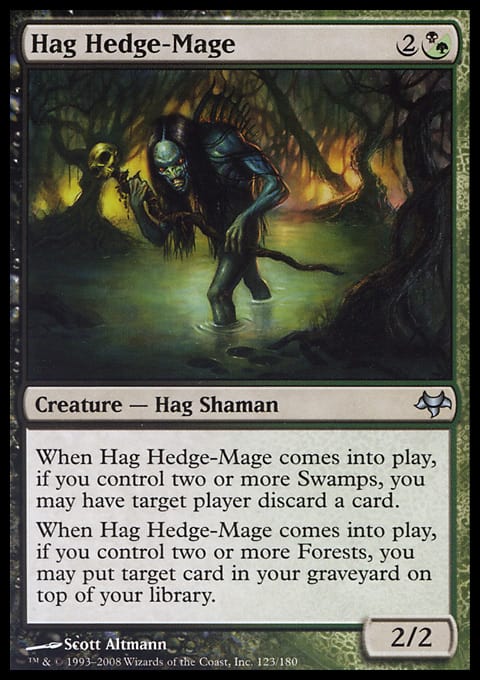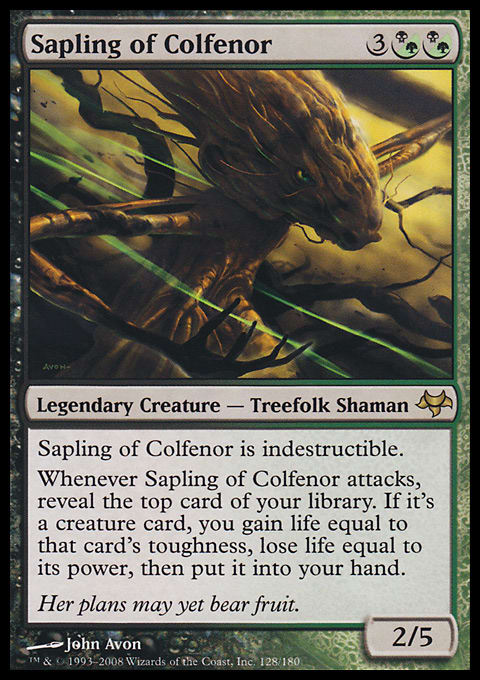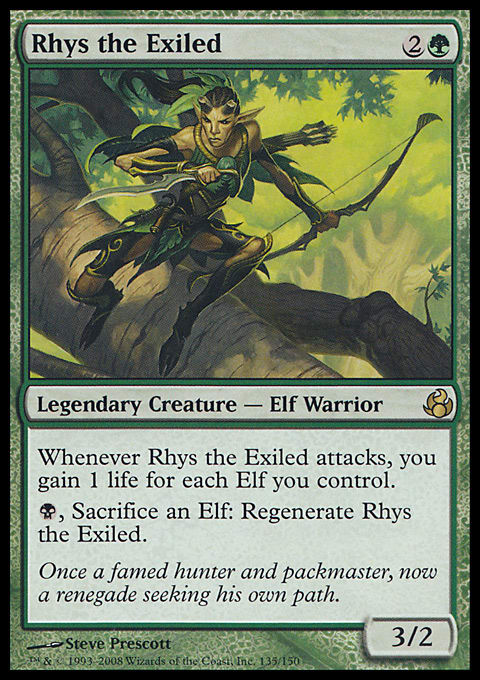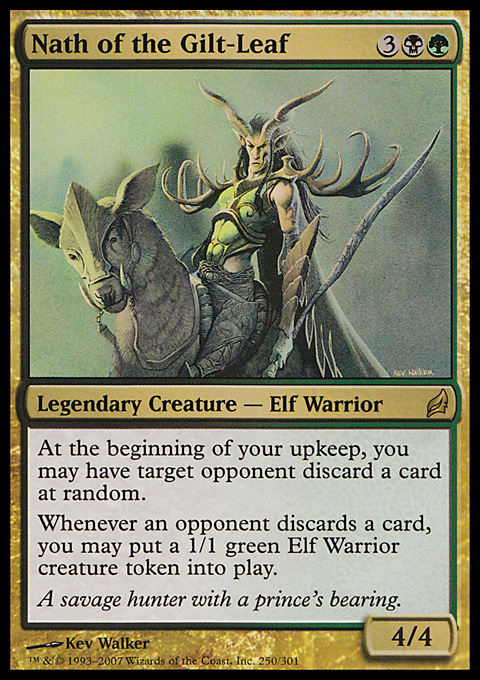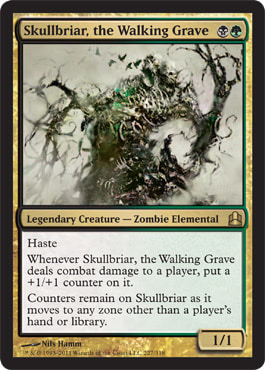It’s taken us four weeks, but we've finally arrived! When it comes to Commander, Golgari is my spiritual home. My first ever deck was built around Teneb, the Harvester, and I guess that wasn’t enough to satisfy my craving for that gorgeous, gory, grinding, Golgari goodness because my next deck was Vorosh, the Hunter. Fast forward a couple of years, and most of my thirty-odd decks still contain either black or green, and my favorites usually combine them.
What makes Golgari so much fun to play? I'm glad you asked!
Strengths
This is the guild of growth, decay, and death. If you're comfortable spending as much time in the dark as the light, Golgari might just grow on you.
Circle of Life
Green likes to create and grow things, and black likes watching things die. The result is a combination that not only kills and regrows better than any other guild but also allows you to squeeze advantage out of both sides of the equation. The new Soul of the Harvest/Harvester of Souls cycle illustrates this perfectly: When new life is created, you win, and when that life meets its inevitable end, you win even more. Another example of this is the overlap of Lhurgoyf-and-Mortivore-style effects that Golgari enjoys, not least of which is their new guild leader, Jarad (who was just released today as I write this, and who looks awesome). Golgari thrives on the chaos of multiplayer, which is why it might just be the strongest multiplayer guild.The Bitch Is Back
So yeah, Golgari brings stuff back; that shouldn't surprise anyone. Their creatures come back, their creatures bring other creatures back, and some of their creatures even bring back spells. Golgari has no problems keeping hands full of tasty critters to play, and if you like attrition, the prospect of playing your threats more times than your opponents have answers is irresistible.
I Feel Like a Bullet
There is no better feeling than having all the answers, and Golgari is one of the best color pairings in terms of complementary removal. Black handles the critters, and green handles everything else, and between the two of them, there is nothing you can't sweep away or pinpoint mercilessly—which is presumably why Vindicate became Maelstrom Pulse and the new Abrupt Decay.
All the Nasties
What makes it even sweeter is that Golgari has so many of its answers in creature form: slimes and Assassins whirl around between the graveyard and the battlefield in a sweet ballet of destruction . . .
I’m sorry; value removal always makes me sentimental. The bottom line is that while white’s Angels and red’s Dragons are sexy, powerful, and exciting to play, Golgari has the best choice of critters for any occasion as far as I’m concerned, and they become even better when they don’t stay dead.
Weaknesses
Mechanically, Golgari has less ability to interact with the stack than any other color—even white can Silence the combo mage temporarily—so there is an inherent vulnerability to combos, direct damage, and decks that win out of nowhere (think Insurrection and Craterhoof Behemoth as examples).
On top of that, I think most Golgari builds tend to be drawn in certain directions, leading to a more fundamental weakness in how they play. Golgari’s strengths lie in its creatures and sorceries (and with Vraska the Unseen, also its planeswalkers, but I’ll talk more about her later) and in drawing and recurring cards. However, that often means you're forced to choose from an overwhelming selection of bombs in hand—which doesn’t really sound like a problem—and using all of your mana on your own turn.
As a result, it is essential to put a Golgari deck together with interactivity in mind. Putrefy is already one of the best spot removal cards in the game, but you need to make sure that it is just one of a dozen or so spells you can cast on your opponents’ turns no matter how many more powerful sorceries you have to cut. That might imply a greater number of Fog/Darkness variants than other decks; because Golgari tends to win the long game, anything that stops your opponents from rolling over you will help to cement your victory.
This also explains why I have (need) Seedborn Muse in both my Teneb and Vorosh decks. Teneb in particular always wants to tap out for fat creatures, recursion engines, and back-breaking sorceries, so Seedborn Muse helps me to deliver the haymakers while also keeping my guard up. Elvish Piper and Quicksilver Amulet are two more great ways to increase interactivity in Golgari, and you can also explore options such as Lurking Predators (seriously, why wouldn’t you?), Lure of Prey, Call of the Wild, and Corpse Dance.
Hidden Gems
Golgari is the hardest color to write this section for, and it’s not because there are so few cards with a B/G color identity. Rather, it’s because so many B/G cards have been such absolute ball-busters that they are now widely known gems. How many guilds can boast a top five like this?That is some serious power right there. The only reason Spiritmonger isn’t played in every B/G deck is the proliferation of cards like Lord of Extinction that compete for the same spot on your curve, but it is still a massive and resilient threat that has won more than its share of games. Here are some other weapons for your arsenal:
Canker Abomination – There is always someone at the table who doesn’t have any creatures; in fact, if you’re playing black, it is your job to make sure that this is the case. That means that Canker Abomination will almost always be a 6/6 for 4 mana. While not quite as large as the original (gamma-fueled) Abomination, this is a wonderful budget option at the very least. Plus, scary veggies!
And I couldn't leave off without pointing out how fantastic Golgari’s creatures are for budget sixties. Start with a core of Woodlurker Mimic or Lotleth Troll, Ebony Treefolk or Dreg Mangler, Canker Abomination, Noxious Hatchling or Corpsejack Menace, and the world is your mollusk. And as Sean Smith mentioned on Twitter, Corpsejack Menace works brilliantly with undying creatures. Strangleroot Geist looks even better as a 4/3!
Creakwood Liege – One of the best of the Liege cycle, Creakwood pumps an extraordinarily aggressive tribe and provides more fuel for the Golgari engine. Whether you are the beatdown or a sac-happy combo or control deck, get yourself a Liege.
Doomgape – Another fine example of Golgari benefiting from death and destruction, Doomgape is what Lord of the Pit always dreamed of being: always good, often great, and perfect for a deck that keeps a steady flow of traffic between the graveyard and battlefield. At the very least, Doomgape is a 10/10 for 7 that should survive long enough to deter an attack (or eat an attacker), and then sac itself to give you 10 life. That seems pretty good for a downside mechanic . . . in fact, excuse me while I go and put one in my Kresh deck!
Gleancrawler – Gleancrawler is one of the cards at the heart of my Teneb deck, and I’m thrilled to see it getting some love in the new Duel Decks (along with my all-time favorite Izzet card, which I’ll talk more about next week). Here’s what Gleancrawler doesn’t do: It doesn’t bring cards back into play, and it doesn’t bring back stuff that your opponents kill on their turns. But it still does plenty:
- Keeps upkeep sacrifices flowing
- Makes evoke critters even better
- Allows you to attack more aggressively
- Dials Birthing Pod up to 11
- Follows up sweepers like a boss
- Beats down like a huge beating thing
Gleancrawler was carefully tailored to avoid any arbitrarily large shenanigans, which I appreciate, but for sheer deal-with-me-now-or-die value, it’s hard to beat this Insect Horror.
Golgari Germination – I've already looked at how Golgari turns dead critters into other resources, but perhaps the most important resource for a sac engine is more creatures, and that’s exactly what you have with this heavy-hitting lightweight.
Grim Feast – It almost seems unfair putting this in the same color as Damnation, but Grim Feast exemplifies Golgari’s ability to benefit from death. Even if it’s wiped out by the first sweeper, you can still gain a huge amount of life from it.
Hag Hedge-Mage – One of the best of the Hedge-Mage cycle, the Hag giveth (to you) and the Hag taketh away (from your opponent). If you use her just once to recur a key spell and then chump with her, you’re still well ahead of the game, but if you can recur her just a little bit, the gains can be staggering. Favorite things to recur with her are: Sword of Light and Shadow and Victimize.
Necrogenesis – Sheldon Menery, the godfather of Commander, is forever going on about graveyard removal, but he mainly talks about artifacts such as Tormod's Crypt and Relic of Progenitus. Golgari is often on the receiving end of graveyard hosers, but it can also dish them out better than any other guild. Necrogenesis headlines a group that includes Scavenging Ooze, Nezumi Graverobber, Night Soil, and Withered Wretch.
Vulturous Zombie – Last week, I ranked Asmira, Holy Avenger as Fair to Middlin’, and this is the reason. Golgari has the tools to do efficiently what Asmira, Cat Lady just can't. Notice how Vulturous Zombie shares the same language as Bloodchief Ascension, meaning it can do horrible things with a Mindcrank, and it probably works best with a discard-heavy Nath of the Gilt-Leaf deck.
Grim Backwoods – It’s a mite more expensive than Commander staple High Market, but then, drawing a card is much more useful than gaining 1 life. This is a great target of Expedition Map, Reap and Sow, or Sylvan Scrying.
Meet the Boss
Looking at the Golgari commanders as a whole, you can't help but be impressed by how well they scale for multiplayer. Savra, Glissa, and Jarad obviously gain a great deal of power as the players multiply, but they aren’t the only ones.
Crap
Iname as One – Here is all you need to know: The exile ability of Iname doesn’t work unless you exile it, just as Child of Alara doesn’t work unless you let it go to the graveyard. In other words, you only get to reanimate something once, and there are more efficient reanimators in the game. This overpriced, underpowered, inexplicably non-flying, one-trick pony1 may actually be the worst Commander in the game.
Fair to Middlin’
I’m fully aware that my four-tier system for ranking the potential power of commanders has holes that you could drive a Baloth through, but Golgari is the only guild for which it has really given me trouble. Considering my natural proclivities for B/G/x decks, I decided to err on the side of caution and put three commanders in this category, but I could have just as easily promoted them all to the Johnnyable tier. That’s quite a testament to the power of Golgari!
Sapling of Colfenor – There are only four2 indestructible commanders: Sapling of Colfenor, Avacyn, Angel of Hope, Konda, Lord of Eiganjo, and Ulamog, the Infinite Gyre. The Sapling is the cheapest, and with her, you don’t have to play anything as weird as all colorless or as dull as mono-white.
Her ability is not actually too bad, potentially giving you both life and free cards, but unless you build around her completely, it’s just too random and restrictive. On the other hand, you have to be realistic about what the payoff is if you jump through the hoops that the commander requires, and for the Sapling, the payoff just isn’t quite enough. Most of the creatures you would want to play in these colors would have power at least as great as their toughness, which means you’re paying life while advertising how aggressive your hand is, and these are not colors that struggle to draw cards in other ways, so it’s just not worth it in pure power terms.
By all means, consider putting her in a deck with Treefolk, Gorgons, Basilisks, Spiders and the like, or just loading her up with an assortment of blunt and edged weapons and blow up the board so that she can beat face uninterrupted, but don’t expect the result to be a world-beater. On the other hand, if you do have a fierce Sapling of Colfenor deck, I’d love to see the list!
Rhys the Exiled – Rhys the Younger has a Golgari color identity, which is a little bit weird because he is clearly designed to spearhead an army of Elves, very few of whom are black.
Vhati il-Dal – Vhati formerly of the Dal is a hell of a lot of fun to play with and can deter an awful lot of attacks. You can use first strikers or a card like Caltrops to make the threat of giving a creature 1 toughness more meaningful or use deathtouchers and protect them by giving your opponents’ creatures 1 power. And obviously, his ability works just as well in combat steps that you aren’t involved.
While Vhati only changes a creature’s base power or toughness, playing green allows you to take Equipment and enchantments out of the equation, and Vampire Hexmage removes any +1/+1 counters. Despite all of that utility, I couldn't quite bring myself to rank him as a powerhouse because he can only mess with one creature per turn, and he isn’t guaranteed to kill anything (unless you pair him with Horobi, Death's Wail—hey, there’s an idea!).
Just Johnnyable
Nath of the Gilt-Leaf – Nath’s first ability doesn’t scale, requiring you to target a particular opponent each upkeep, but his second ability is where the multiplayer payoff lies. You can cast spells such as Unnerve and watch the ranks of your elven army swell, but you will ultimately find that neither discard nor 1/1 Elves are strong enough to take control of the kitchen table without some serious support. I recommend starting with Words of Waste with Geth's Grimoire and Flourishing Defenses with Black Sun's Zenith.
Glissa, the Traitor – I revamped my Glissa Rock deck this summer, and it is now a lot stronger and a lot more fun to play. She requires playing with a ton of artifacts, to the extent that her ability will usually be wasted in most decks, but when you build it right, she’s dynamite. Recurring an Armillary Sphere or Nihil Spellbomb is solid value; reusing an Oblivion Stone or Jester's Cap is brutal, and bringing back a Wurmcoil Engine every turn is just back-breaking. I still think Glissa is among the most interesting and challenging commanders to build and play that I’ve ever seen.
Powerhouses
Sisters of Stone Death – We’ve looked at a lot of over-costed commanders so far, but none of them deliver as much power as the Sisters. In casual world, we don’t mind paying this much for a truly awesome commander, especially in green, and the potential of the Sisters is just irresistible. Swing once with 6 mana open, and you own the next-scariest creature on the board. Swing with 9 mana open, and you have the luxury of just exiling you opponent’s three best critters. Plus, that second ability works on defense as well, so if you get to cast her with 2 mana open, she’ll be a fantastic deterrent. That’s the difference between over-costed and expensive-but-worth-it.
Skullbriar, the Walking Grave – One of the most mechanically unique commanders in the game, Skullbriar is the King of Aggro. You still have a lot of options in terms of how you use him—any strategy can be supplemented by the constant threat of hasty commander-beats—but if you're running The Grave That Walks, you know you want to force the tempo of the game.
Consider how perfectly Skullbriar synergizes with the upcoming scavenge mechanic: Your exiled creatures are gone forever, but their power will live on through Skullbriar. It’s a thing of beauty. Just be careful to play around bounce and tuck effects, especially Hinder and friends
Savra, Queen of the Golgari – Like Lyzolda from Rakdos, Savra moves from Johnnyable to Powerhouse because she’s so good with any creatures. Ideally, you want to build around her ability with B/G critters, but there’s nothing wrong with just saccing whatever mono-colored creatures you can find. Grave Pact as your commander is pretty good I hear!
Jarad, Golgari Lich Lord – Jarad is ridiculously powerful, with two abilities that scale perfectly for multiplayer and a third ability that is perfect for a long game with plenty of ramp and sweepers. I suspect we have Ken Nagle to thank for this one, and I'm also pretty sure that we will never see a more powerful Golgari commander than this.
Golgari Gambits
Golgari is as wide open as any other guild, but if you’re traveling to the undercity for the first time, here are some ideas to get you started:
- Kick in the Sac – This is a no-brainer. Go all-in on cards that sacrifice, creatures that give you something when they're sacrificed, and things that care about other stuff dying. Then, squeeze in a few different ways of bringing them back to do it all over again. Golgari Guildmage is mana-intensive but a great budget card to start with, and Oath of Ghouls is a favorite if you have more dead stuff than anyone else.
- Aggro – You only need to look at the Return to Ravnica spoiler for thirty seconds to realize that Golgari is going to be one of the most aggressive decks in Standard for the next couple of years. Play high-powered, hasty beaters, spot removal, and recursion like Living Death for when you eventually run out of steam.
- The Rock – Check out the link to my Glissa deck mentioned above for some ideas for porting a successful duel archetype into multiplayer. Nobody grinds like Golgari!
- Proliferation – Golgari has a lot of counters—usually +1/+1 counters—and the soon-to-cycle Scars of Mirrodin block is full of tasty ways to abuse those. This would be a great way to build your first Commander deck if you’ve only been playing for a year or so.
On that note, let me close with a decklist from a good friend of mine, Tony Ezzell. His Skullbriar build gives you some good ideas for either an aggro or counter-themed Golgari build. Enjoy!
"Skull-Bleeping"
- Commander (0)
- Lands (36)
- 8 Forest
- 11 Swamp
- 1 Command Tower
- 1 Golgari Rot Farm
- 1 Tainted Wood
- 1 Woodland Cemetery
- 1 Vivid Marsh
- 1 Hickory Woodlot
- 1 Peat Bog
- 1 Llanowar Reborn
- 1 Mosswort Bridge
- 1 Oran-Rief, the Vastwood
- 1 Bojuka Bog
- 1 Terramorphic Expanse
- 1 Evolving Wilds
- 1 Buried Ruin
- 1 Ghost Quarter
- 1 Tectonic Edge
- 1 Temple of the False God
- Ramp (9)
- 1 Fertilid
- 1 Cultivate
- 1 Kodama's Reach
- 1 Explosive Vegetation
- 1 Ranger's Path
- 1 Garruk Wildspeaker
- 1 Drumhunter
- 1 Harmonize
- 1 Harvester of Souls
- Removal (12)
- 1 Naturalize
- 1 Gleeful Sabotage
- 1 Grim Affliction
- 1 Putrefy
- 1 Vow of Wildness
- 1 Icy Manipulator
- 1 Slice in Twain
- 1 Acidic Slime
- 1 Spread the Sickness
- 1 Profane Command
- 1 Black Sun's Zenith
- 1 Terastodon
- Tutors (10)
- 1 Demonic Tutor
- 1 Beseech the Queen
- 1 Mwonvuli Beast Tracker
- 1 Diabolic Tutor
- 1 Brainspoil
- 1 Diabolic Revelation
- 1 Liliana Vess
- 1 Green Sun's Zenith
- 1 Rune-Scarred Demon
- 1 Increasing Ambition
- Counters (12)
- 1 Forgotten Ancient
- 1 Ob Nixilis, the Fallen
- 1 Triskelion
- 1 Vigor
- 1 Contagion Clasp
- 1 Ring of Xathrid
- 1 Ring of Kalonia
- 1 Increasing Savagery
- 1 Blessings of Nature
- 1 Doubling Season
- 1 Contagion Engine
- 1 Eternity Vessel
- Creature Enhancement (12)
- 1 Roughshod Mentor
- 1 Rancor
- 1 Bladed Pinions
- 1 Nim Deathmantle
- 1 Swiftfoot Boots
- 1 Trailblazer's Boots
- 1 Darksteel Plate
- 1 Sword of Vengeance
- 1 Whispersilk Cloak
- 1 Untamed Might
- 1 Vigor Mortis
- 1 Asceticism
- Misc. Utility (8)
- 1 Korozda Guildmage
- 1 Prized Unicorn
- 1 Spike Weaver
- 1 Tormod's Crypt
- 1 Noxious Revival
- 1 Reclaim
- 1 Gutter Grime
- 1 Sorin Markov
As you can see, he has a massive focus on counters—the thirteen-card section above doesn’t even include two removal spells that have proliferate! So it’s clear that Skullbriar is going to come out early and often, and Tony’s going to try to squeeze out every possible ounce of beatage from that dead plant dude with Equipment and whatnot.
He has a relatively small number of other potential win cons—creatures that slot into other functions—and uses a very strong tutor suite to keep the pressure on. His removal suite is solid, and he has the tools in here to deal with anything his opponents might throw at him.
Let me end with a word on how this deck impacts the tutor debate in Commander. Tony has only been playing for about eighteen months, and he’s a guy who totally gets the format. Even when he’s kicking my ass with a control deck, he’s still a ton of fun to play with, so let’s not assume that many tutors somehow equals unfun or broken. Tony has an incredibly eclectic decklist, and the tutors allow him to pick from a menu of answers to support his main threat, Skullbriar. At the same time, he’s going to be going for a different card in most cases. The worst you can say is that Doubling Season is a too-tempting tutor target, but even then, it doesn’t go crazy with Skullbriar, and I trust Tony not to go nuts on doubling planeswalkers.
This is both a fun deck to play and a fun deck to play against; what more can we ask?
1 Unless you fancy chaining Riftsweeper to keep bringing Iname back from exile, in which case you may have too much time on your hands.
2The Myojin from Champions of Kamigawa are legendary creatures that are indestructible only if cast from your hand, which rules them out as commanders for most decks. If you want to take the challenge, though, you need to start with That Which Was Taken.
















